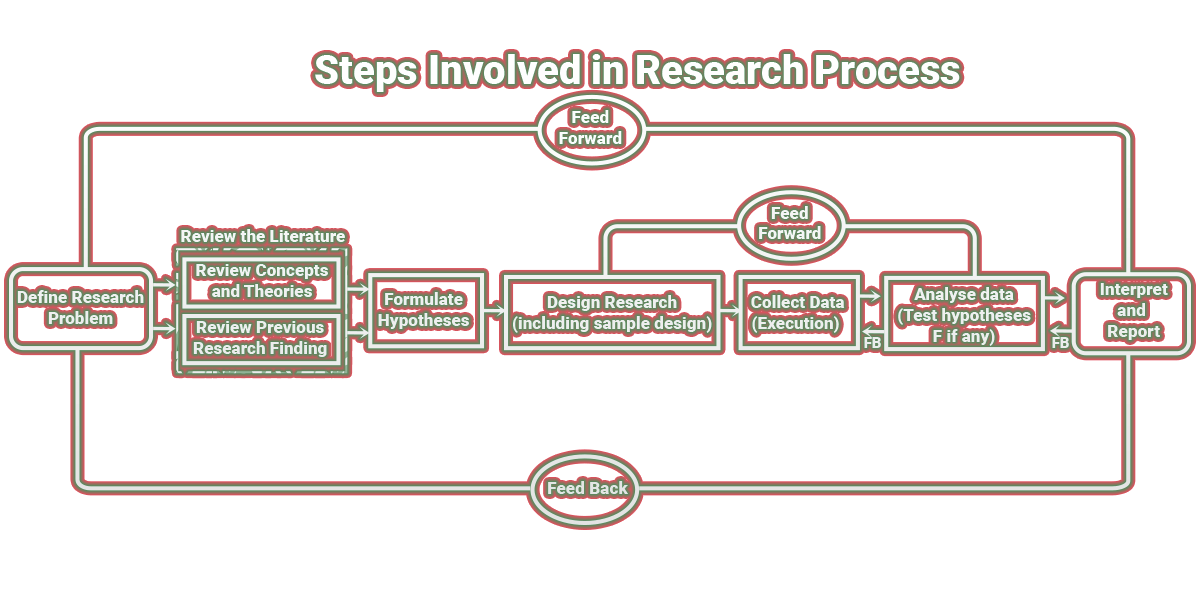Steps Involved in Research Process:
The research process consists of a series of actions or steps necessary to effectively carry out research and the desired sequencing of these steps. The research process consists of a number of closely related activities but such activities overlap continuously rather than following a strictly prescribed sequence. One should remember that the various steps involved in a research process are not mutually exclusive, nor they are separate and distinct. They do not necessarily follow each other in any specific order and the researcher has to be constantly anticipating at each step in the research process the requirements of the subsequent steps. However, the following order concerning various steps involved in the research process:
i. Formulating the Research Problem: There are two types of research problems, viz., those which relate to states of nature and those which relate to relationships between variables. The best way of understanding the problem is to discuss it with one’s own colleagues or with those having some expertise in the matter. In an academic institution, the researcher can seek help from a guide who is usually an experienced man and has several research problems in mind. Often, the guide puts forth the problem in general terms and it is up to the researcher to narrow it down and phrase the problem in operational terms. In private business units or in governmental organizations’, the problem is usually earmarked by the administrative agencies with whom the researcher can discuss as to how the problem originally came about and what considerations are involved in its possible solutions.
ii. Extensive Literature Survey: Once the problem is formulated, a brief summary of it should be written down. It is compulsory for a research worker to write a thesis for a Ph.D. degree to write a synopsis of the topic and submit it to the necessary Committee or the Research Board for approval. At this stage, the researcher should undertake an extensive literature survey connected with the problem. For this purpose, the abstracting and indexing journals and published or unpublished bibliographies are the first place to go. Academic journals, conference proceedings, government reports, books, etc., must be tapped depending on the nature of the problem. In this process, it should be remembered that one source will lead to another. A good library will be a great help to the researcher at this stage.
iii. Development of Working Hypotheses: Working hypothesis is a tentative statement made in order to draw out and test its logical or empirical consequences. As such the manner in which research hypotheses are developed is particularly important since they provide the focal point for research. They also affect the manner in which tests must be conducted in the analysis of data and indirectly the quality of data that is required for the analysis. The development of the working hypothesis plays an important role in maximum research. Hypothesis should be very specific and limited to the piece of research in hand because it has to be tested. The role of the hypothesis is to guide the researcher by delimiting the area of research and to keep him on the right track. It sharpens his thinking and focuses attention on the more important facets of the problem. It also indicates the type of data required and the type of methods of data analysis to be used.
iv. Preparing the Research Design: The research problem having been formulated in clear cut terms, the researcher will be required to prepare a research design. The preparation of the research design, appropriate for a particular research problem, involves usually the consideration of the following:
- the means of obtaining the information;
- the availability and skills of the researcher and his staff (if any);
- explanation of the way in which selected means of obtaining information will be organized and the reasoning leading to the selection;
- the time available for research; and
- the cost factor relating to research, i.e., the finance available for the purpose.
v. Determining Sample Design: The researcher must decide the way of selecting a sample of what is popularly known as the sample design. In other words, a sample design is a definite plan determined before any data are actually collected for obtaining a sample from a given population.
vi. Collecting the Data: collecting the appropriate data which differs considerably in the context of money costs, time, and other resources at the disposal of the researcher. Primary data can be collected either through experiments or through a survey. If the researcher conducts an experiment, he observes some quantitative measurements, or the data, with the help of which he examines the truth contained in his hypothesis. It includes – observation, personal interview, telephone interviews, mailing of questionnaires, schedules, etc. The researcher should select one of these methods of collecting the data taking into consideration the nature of the investigation, objective and scope of the inquiry, financial resources, available time, and the desired degree of accuracy.
vii. Execution of the Project: The researcher should see that the project is executed in a systematic manner and in time. If the survey is to be conducted by means of structured questionnaires, data can be readily machine-processed. The survey is under statistical control so that the collected information is in accordance with the pre-defined standard of accuracy. If some of the respondents do not cooperate, some suitable methods should be designed to tackle this problem.
viii. Analysis of data: After the data have been collected, the researcher turns to the task of analyzing them. The analysis of data requires a number of closely related operations such as the establishment of categories, the application of these categories to raw data through coding, tabulation, and then drawing statistical inferences to use computers. Computers not only save time but also make it possible to study a large number of variables affecting a problem simultaneously. The researcher can analyze the collected data with the help of various statistical measures.
ix. Hypothesis-testing: The hypotheses may be tested through the use of one or more of such tests, depending upon the nature and object of the research inquiry. Hypothesis-testing will result in either accepting the hypothesis or in rejecting it.
x. Generalizations and Interpretation: If a hypothesis is tested and upheld several times, it may be possible for the researcher to arrive at generalization, the real value of research lies in its ability to arrive at certain generalizations. If the researcher had no hypothesis to start with, he might seek to explain his findings on the basis of some theory. It is known as interpretation. The process of interpretation may quite often trigger off new questions which in turn may lead to further researches.
xi. Preparation of the Report: Finally, the researcher has to prepare the report of what has been done by him. Writing of report must be done with great care keeping in view the following:
The layout of the report should be as follows:
(i) Preliminary pages the report should carry title and date followed by acknowledgments and foreword. Then there should be a table of contents followed by a list of tables and list of graphs and charts, if any, given in the report.
(ii) The main text of the report should have the following parts:
(a) Introduction: It should contain a clear statement of the objective of the research and an explanation of the methodology adopted in accomplishing the research. The scope of the study along with various limitations should as well be stated in this part.
(b) Summary of findings: After the introduction, there would appear a statement of findings and recommendations in non-technical language. If the findings are extensive, they should be summarized.
(c) Main report: The main body of the report should be presented in a logical sequence and broken-down into readily identifiable sections.
(d) Conclusion: Towards the end of the main text, the researcher should again put down the results of his research clearly and precisely. In fact, it is the final summing up.
(iii) At the end of the report, appendices should be enlisted in respect of all technical data. Bibliography, i.e., list of books, journals, reports, etc., consulted, should also be given in the end. Index should also be given specially in a published research report.
- Report should be written in a concise and objective style in simple language avoiding vague expressions such as ‘it seems,’ ‘there may be’, and the like.
- Charts and illustrations in the main report should be used only if they present the information more clearly and forcibly.
- Calculated ‘confidence limits’ must be mentioned and the various constraints experienced in conducting research operations may as well be stated.
It is apparent that the research process includes several steps which help to complete a research monograph or thesis paper in a convenient way. So, we should follow the steps involved in the research process when we are going to do a research project.
Reference: Research Methodology, 2nd Edition, written by C.R. Kothari
Related Article: Research | Objectives of Research | Types of Research | Characteristics of Research

Assistant Teacher at Zinzira Pir Mohammad Pilot School and College










